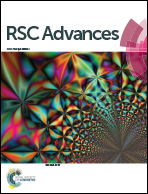Comparison of different chemometric methods in quantifying total volatile basic-nitrogen (TVB-N) content in chicken meat using a fabricated colorimetric sensor array†
Abstract
Total Volatile Basic-Nitrogen (TVB-N) content is one of core measures in evaluating chicken freshness. This study reported the feasibility to quantify Total Volatile Basic-Nitrogen (TVB-N) content in chicken meat by a low cost colorimetric sensor array with the help of chemometric analysis. We fabricated a colorimetric sensor array by printing 12 chemically responsive dyes (i.e. 9 porphyrins/metalloporphyrins and 3 pH indicators) on a C2 reverse silica-gel flat plate for the fast and non-destructive quantitative determination of TVB-N content in chicken. A colour change profile for each sample was obtained by differentiating the image of the sensor array before and after exposure to volatile organic compounds (VOCs). Linear algorithm; partial least squares regression (PLSR) and nonlinear algorithms; back propagation artificial neural network (BPANN), Adaptive Boosting BPANN (BP-AdaBoost) and support vector machine regression (SVMR) methods based on particle swarm optimization (PSO) were used to build the TVB-N prediction model. Experimental results showed that the predictive precision of the PSO-SVMR model was superior to linear and classic non-linear models. The optimum PSO-SVMR model was obtained with 4 support vectors and Rp of 0.8981, RMSEP of 5.5255. The overall results are encouraging for the application of low cost colorimetric sensors combined with an appropriate chemometric method in the poultry industry for quality assessment because it is practical, non-invasive, rapid and simple.


 Please wait while we load your content...
Please wait while we load your content...